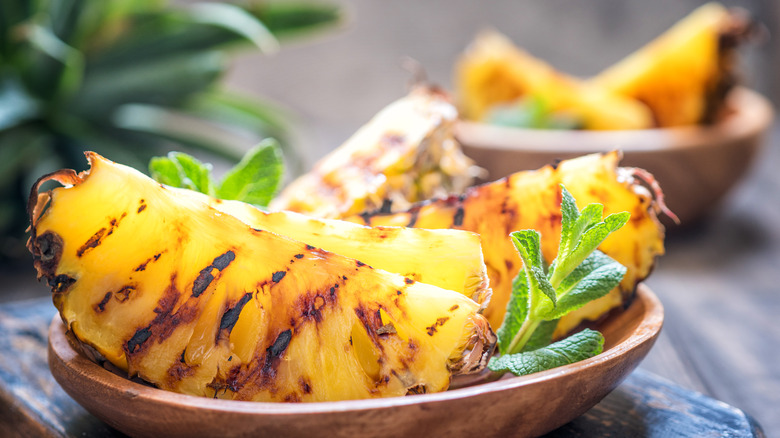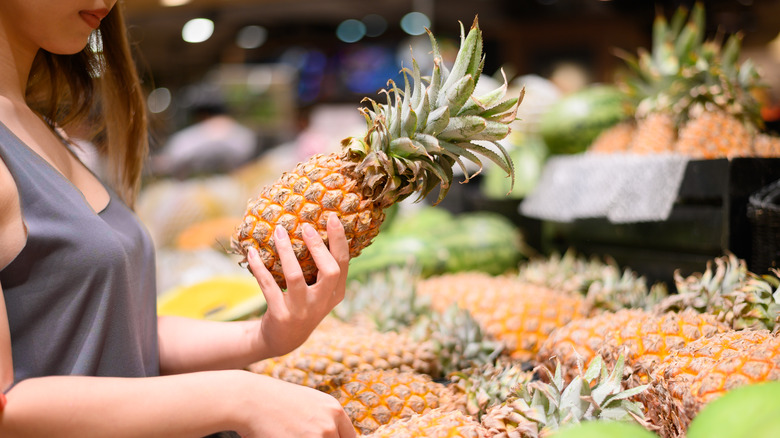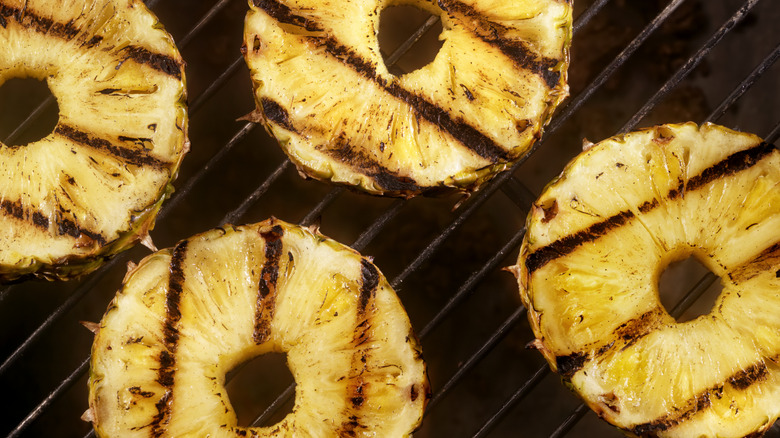The Important Tip That Could Make Or Break Your Grilled Pineapple
Grilled pineapple is sweet, tender, and a touch smoky. Or, at least, it should be. The best version of the charred fruit heightens its natural caramel notes and sugars, but only when it's prepared the right way.
The secret is not in the way you chop pineapple or its marinade, but in the fruit itself. For the best possible grilled pineapple, you need to use the freshest, ripest produce possible. If it tastes delicious when you slice into it, it'll taste even better after a brush with some flames. If the flesh is bland or mild, as the canned rings can be, the grilled portions will have a duller flavor and mushiness to them. Same with underripe fruit, which may remain slightly crunchy after a quick grill, and have a muted taste.
The sugar content of pineapples increases as they ripen, which means peak produce is primed to become richer and more honeyed when paired with heat. The grill also makes the fruit more palatable in some cases, as the heat neutralizes the enzymes that can make your mouth burn (unless you use salt water to take the sting out). And that means anyone adverse to the acidic ingredient inside the fruit may find themselves rethinking taking a bite.
How to tell if your pineapple is ripe
Like picking the perfect watermelon or cantaloupe, selecting pineapple at the grocery store requires detective work and some luck. Start by double checking you're shopping during the best time of year for tropical fruit, as this will up your chances of striking gold. Then peruse the produce section for specimens with a super yellow exterior, the first hint that they're ripe. Skip over green-hued rinds since, unlike bananas, the under ripened fruit won't sweeten if you take it home and wait.
Next, weigh the fruit with your hands and select the heaviest, juiciest one. Then, give it a sniff. A bright, syrupy smell is another great clue that it'll taste delicious, whereas a sour funk indicates it's over the hill.
As you're examining the produce, squeeze gently with your fingers as well to check the flesh. It should have a slight give, and feel neither squishy nor rock hard. Pull the leaves at the top, too. If the fronds are hard to maneuver, your selection is likely underripe; leaves that offer a good wiggle or easy separation are a helpful final sign you've picked a good one.
Grilling pineapple for the tastiest results
If you're new to grilling fruit, here are some ideas on how to season and serve it. One of the easiest entry points is dessert. You can grill the fruit plain, but cooks can also borrow a technique favored at Brazilian-style steakhouses. Toss long wedges in brown sugar and cinnamon before cooking, then serve after a meat-heavy meal. The heat will bring out more of the nutty, caramel notes of the ingredients for a treat that begs for a scoop of ice cream or yogurt.
The yellow flesh also shines in savory applications. You may have spotted the fruit on top of chicken al pastor tacos, as pineapple serves to both moisturize the meat as it cooks and garnish tacos. You can replicate this application, or chop the fruit into pieces and toss with herbs and acid for a Mexican-inspired salsa. For an Indian street food-inspired bite, invoke the idea of chaat masala to pair with cilantro and lime.
You can also imbue the fruit with savory, spicy seasonings to help wake up your tastebuds. Treat the chunks like any other summer produce and brush them with oil, spices, salt, and lime. Try using chili powder for a kick, as well as a dash of spices like cumin and paprikato highlight the smoky char. Aromatic blends like warmly spiced ras el hanout and floral baharat can also hold their own in sweet-savory applications, so you can experiment with them, too.



